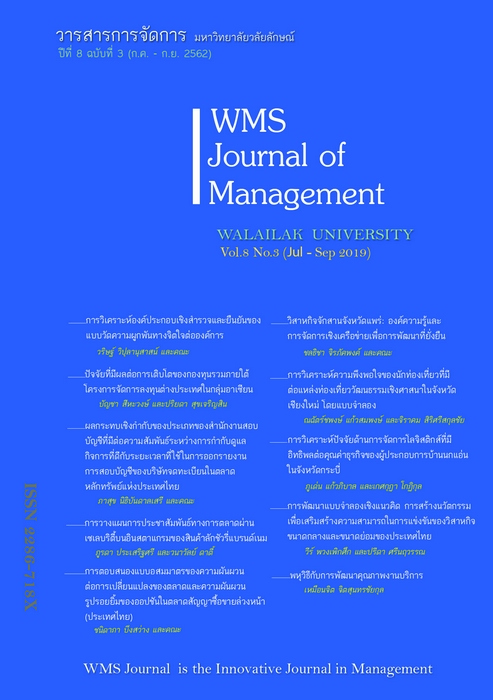Multiplicity of Approaching to Service Quality Development
Main Article Content
Abstract
It is irrefutable that the majority of customer, unsatisfied customer is a negative experience with or without complaining, this paper proposes a definition of service quality, with the several service recovery approaching. The premise of this paper is that each service recovery approaching should have service quality development criteria that specifically fit its service model, customer expectation and customer experience. To implement this context, it is argued that an entrepreneur should be able to comprehend customer insights, there are 5 types of customer-service provider relationship relied on interaction between customer involvements and service providing. Empowered employee delegating is one approaching to empowered customer for service quality development. Furthermore, it embraced with various types of creative service innovation are creative workplace for innovation, impressed experiences, and integrated service tasks. Last but not least, to proactively compete in service industry, implications for developing service quality that promises to capture customer are given.
Article Details
References
Coulter, A., & Ligas, M. (2000). A typology of customer-service provider relationships: the role of relational factors in classifying customers. Journal of Service Marketing, 18(6), 482-493.
De Matos, C. A., Henrique, J. L., & Alberto Vargas Rossi, C. (2007). Service recovery paradox: a meta-analysis. Journal of Service Research, 10(1), 60–77. doi.:10.1177/1094670507303012
Eccles., G., & Durand, P. (1998). Complaining customers, service recovery and continuous improvement. Managing Service Quality, 8(1), 69.
Edvardsson, B., & Olson, J. (1996). Valued –based service for sustainable business: Lessons for IKEA. UK: Abingdon: Routledge.
Einstein, A. (1931). Einstein on Cosmic Religion and Other Opinions and Aphorisms. Retrieved from http://todayinsci.com/E/ Einstein_Albert/EinsteinAlbert-ImaginationQuote500px.htm
Fisk, P. (2011). Creative genius, Capstone. Chichester, UK: Wiley Company.
Fitzsimmons, J. A., & Fitzsimmons, M. J. (2008). Service Management: Operations, Strategy, Information Technology (6th ed.). NY: McGraw-Hill.
Frei, F. X. (2008). The four things a service business must get right. Harvard Business Review, 86(4), 70-80.
Gwinner, K. P., Gremler, D. D., & Bitner, M. J. (1998). Relational benefits in service industries: The customer’s perspective. Journal of the Academy of Marketing Sciences, 26, 101-114.
Helkkula, A., Kelleher, C., & Pihlstro¨m, M.(2012). Practices and experiences: Challenges and opportunities for value research. Journal of Service Management, 23(4), 554-570.
Howard, T. J., Culley, S. J., & Dekoninck, E. (2008). Describing the creativity design process by the integration of engineering design and cognitive psychology literature. Design Studies, 29(2), 160-180.
Johnson, M. D. & Seines, F. (2004). Customer Portfolio Management: Toward a DynamicTheory of Exchange Relationships. Journal of Marketing, 68(3), 5.
Matthing, J., Sandén, B., & Edvardsson, B. (2004). New service development: learning from and with customers. International Journal of Service Industry Management, 15(5), 479-498.
Kulpa, J. (2017). Customer relationship management. Retrieved from https://www.forbes.com/ sites/ forbesagencycouncil
Leisen, B., & Vance, C. (2001). Cross-national assessment of service quality in the telecommunication industry: Evident from the USA and Germany. Managing Service Quality, 11(5), 307-317.
Leon, A. K., & Thomas C. R. (1996). Training,empowerment, and creating a culture for change. Empowerment in Organizations 4(3), 26-29.
Miles, I. (2006). Innovation in services. In Fagerberg, J., Mowery, D.C. & Nelson, R.R. (Eds), The Oxford handbook of innovation. 433-458. NY: Oxford University Press.
Nemec, K. (2010). Bozo the Clown was the First Ronald McDonald. Retrieved from http://brokensecrets.com/2010/11/10/bozo-the-clown-was-the-first-ronald-mcdonald
Oak, A. (2007). Innovation types and innovation management practices in service Companies. International Journal of operations & Production Management. 27(6), 564-587.
Parasuraman, A., Zeithaml, V.A., & Berry, L. (1985). A conceptual model of service equality and its implication for future research. Journal of Marketing, 49, 1-50.
Peterson, R. A., & Wilson, W. R. (1992). Measuring customer satisfaction: fact and artifact. Journal of the Academy of Marketing Science, 20(1), 61-71.
Pim den Hertog, Wietze van der Aa, & Mark W. de Jong. (2010). Capabilities for managing service innovation: Towards a conceptual framework. Journal of Service Management, 21(3), 490-514.
Price, L .L., & Arnould, E. J. (1999). Commercial friendships: Service provider-client relationships in context. Journal of Marketing, 63(4), 38-56.
Reid, R. (2018). The business model canvas series: Customer relationships and channels. Retrieved from http://www.ashtonmcgill.com/introducing-business-model-canvas-customer-relationships-channels/
Schneider, B., & White, S. S. (2004). Service quality: Research perspectives. CA: Thousand Oaks, Sage.
Simplicable. (2017). Service Quality. Retrieved from https://simplicable.com/new/service-quality
Solomon, M. (2013). Service Recovery: 7 Rules For Compensating Your Customer (After A Service Or Product Failure). Retrieved from http://www.forbes.com/ sites/micahsolomon/
The Economic Forum. (2016). The Future of jobs report. Retrieve from
https://www.weforum.org/agenda/2016/01/the-10-skills-you-need-to-thrive-in-the-fourth-industrial-revolution/
Vargo & Lusch. (2016). Institutions and axioms: Dominant logic. Journal of the Academic Marketing Science, 44(4), 5 -23.
Wegge, J., Vogt, J., & Wecking, C. (2007). Customer-induced stress in call center work: A company of Audio-videoconference. Journal of Occupational and Organizational Psychology, 80(4), 693-712.
Whittaker & Company. (2018). What types of customer relationship builds value of your business?. Retrieved from
http://www.whittakercpas.com/what-type-of-customer-relationship-builds-value-for-your-business/
Zeng, L., Proctor, L.W., & Salvendy, G. (2009). Fostering creativity in service development: Facilitating service innovation by the creative cognition Approach. Service Science, 1(3),142-153.


